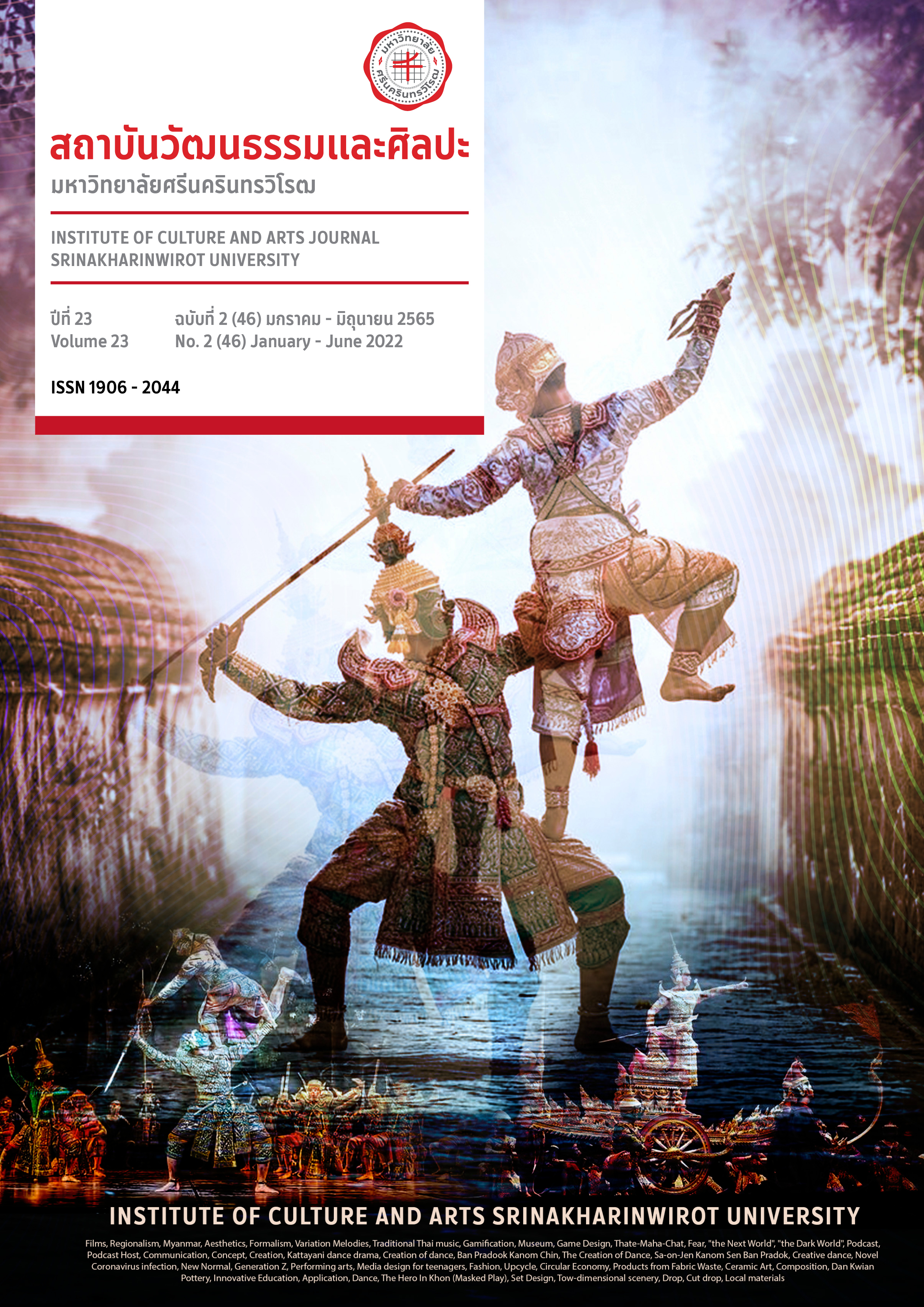พิพิธภัณฑ์ไทยกับการประยุกต์ใช้เกมิฟิเคชั่น: ทบทวนการใช้กระบวนการเกมในบริบทพิพิธภัณฑ์เพื่อการออกแบบเกม
บทคัดย่อ
ในศตวรรษที่ 21 เป็นยุคที่เทคโนโลยีดิจิตอลต่าง ๆ มีอิทธิพลในชีวิตประจำวันทั้งในการทำงาน การศึกษา และการพักผ่อน ทำให้สถานที่หลาย ๆ แห่งปฏิเสธอิทธิพลนี้ได้ยากและต้องปรับตัวนำเทคโนโลยีเข้ามาใช้ทั้งเพื่อความสะดวกสบายและสร้างแรงจูงใจในการมาใช้บริการ พิพิธภัณฑ์ก็เป็นสถานที่หนึ่งที่ต้องปรับตัวเช่นกัน โดยนำเกมในรูปแบบดิจิตอลมาใช้ในนิทรรศการเพื่อสร้างแรงดึงดูดใจและสร้างประสบการณ์การชม ในหลายแห่งใช้ในการดึงดูดผู้ชม ในขณะเดียวกันแนวคิดกระบวนการเกม หรือ เกมิฟิเคชั่น (Gamification) กำลังเป็นที่นิยมแพร่หลายและนำมาใช้ในหลาย ๆ วงการรวมทั้งพิพิธภัณฑ์ แต่การนำแนวคิดเกมิฟิเคชั่นมาประยุกต์ใช้ในบริบทพิพิธภัณฑ์ยังมีความสับนและเป็นข้อสงสัยว่าจริง ๆ แล้วเกมิฟิเคชั่นสำหรับพิพิธภัณฑ์คืออะไร แม้พิพิธภัณฑ์มีการใช้เกมแต่เป็นเกมที่ได้รับการออกแบบผ่านกระบวนการเกมหรือไม่ เกมและการออกแบบเกมโดยใช้หลักกระบวนการเกมสำหรับพิพิธภัณฑ์ควรเป็นอย่างไร บทความวิชาการนี้จึงทบทวนเรื่องแนวคิดกระบวนการเกมโดยครอบคลุมแนวคิดทั่วไปและการออกแบบเกม รวมทั้งเจาะประเด็นวิเคราะห์สถานการณ์เกี่ยวกับการนำกระบวนการเกมไปใช้ในพิพิธภัณฑ์อ้างอิงจากงานวิจัยของต่างประเทศและในไทย จากนั้นจึงอภิปรายเพื่อเสนอแนะแนวทางความเป็นไปได้ของการนำกระบวนการเกมไปใช้ในการออกแบบเกมสำหรับพิพิธภัณฑ์ไทยในอนาคต
Downloads
เอกสารอ้างอิง
กฤษณพงศ์ เลิศบำรุงชัย. (2560). เกมิฟิเคชั่น (Gamification) โลกแห่งการเรียนรู้ที่ขับเคลื่อนด้วยเกม (ออนไลน์). สืบค้นเมื่อ 5 พฤศจิกายน 2564 จาก https://touchpoint.in.th/gamification/
จันทราภรณ์ แสวงกิจ, ศศิพร พงศ์เพลินพิศ, สุชีรา มะหิเมือง. (2563) ผลการใช้เทคนิคเกมมิฟิเคชันในการจัดการเรียนรู้เพื่อพัฒนาพฤติกรรมการมีส่วนร่วมในชั้นเรียนของนักเรียนชั้นมัธยมศึกษาปีที่ 2 โรงเรียนบริบูรณ์ศิลป์รังสิต. วารสารเทคโนโลยีและสื่อสารการศึกษา. 15(19): 33-43. สืบค้นเมื่อ 10 ตุลาคม 2564 จาก https://so01.tci-thaijo.org/index.php/ectstou/issue/view/16718
จุฑามาศ กิติศรี, รัญชนา หน่อคำ, ดุษฎี ก้อนอาทร, พรรณี ไชยวงค์, และคนึงนิจ เพชรรัตน์. (2564). การพัฒนารูปแบบกิจกรรมส่งเสริมพฤติกรรมการเว้นระยะห่างทางสังคมสำหรับนักศึกษาระดับอุดมศึกษาผ่านเกมมิฟิ เคชัน. วารสารเครือข่ายวิทยาลัยพยาบาลและการสาธารณสุขภาคใต้. 8(1): 27-40. สืบค้นเมื่อ 10 ตุลาคม 2564 จาก https://he01.tci-thaijo.org/index.php/scnet/issue/view/16673
ณัฐกมล ถุงสุวรรณ และ ศุภกรณ์ ดิษฐพันธุ์. (2564). การพัฒนาเกมเพื่อการท่องเที่ยวเชิงวัฒนธรรมโดยใช้แนวคิด เกมิฟิเคชัน: กรณีศึกษาจังหวัดน่าน. วารสารศิลปกรรมศาสตร์จุฬาลงกรณ์มหาวิทยาลัย. 8(2): 26-42. สืบค้นเมื่อ 10 ตุลาคม 2564 จาก https://so02.tci-thaijo.org/index.php/faa/issue/view/16932
นฤพนธ์ ด้วงวิเศษ. (2564). มานุษยวิทยากับเกม. [ออนไลน์]. สืบค้นเมื่อ 15 สิงหาคม 2564 จาก https://sac.or.th/main/th/article/detail/232
นวัต เลิศแสวงกิจ และภูวนาท รัตนรังสิกุล. (2564). ศิลปะสื่อสมัยใหม่และกระบวนการเกมิฟิเคชั่นจากความเปลี่ยนแปลง มโนทัศน์วัฒนธรรมจีน-ไทยในผลงาน “21241”. วารสารมหาวิทยาลัยศิลปากร. 41(6). สืบค้นเมื่อ 10 ตุลาคม 2564 จาก https://so05.tci-thaijo.org/index.php/sujthai/issue/view/17092
พัชรสิตา สกุลวงศ์สิริโชค และณัฐสพันธ์ เผ่าพันธุ์. (2564). รูปแบบการสร้างประสบการณ์ลูกค้าของอุตสาหกรรมเครื่องสำอางในประเทศไทย. วารสารมหาจุฬาวิชาการ. 8(2): 254-268. สืบค้นเมื่อ 10 ตุลาคม 2564 จาก https://so04.tci-thaijo.org/index.php/JMA/issue/view/17111
พิสิฐ ตั้งพรประเสริฐ. (2560). สุนทรียะและการออกแบบเกมมิฟิเคชั่นสำหรับการส่งเสริมการท่องเที่ยวรอบเกาะกรุง รัตนโกสินทร์. Veridian E-Journal, Silpakorn University (Humanities, Social Sciences and arts). 10(2). สืบค้นเมื่อ 10 ตุลาคม 2564 จาก https://he02.tci-thaijo.org/index.php/Veridian-E-Journal/issue/view/8373
วิไล อัศวเดชศักดิ์. (2563). การใช้แนวคิดเกมมิฟิเคชั่นในการออกแบบบรรจุภัณฑ์. วารสารศิลปกรรมศาสตร์จุฬาลงกรณ์มหาวิทยาลัย. 7(2): 192-212. สืบค้นเมื่อ 10 ตุลาคม 2564 จาก https://so02.tci-thaijo.org/index.php/faa/issue/view/16685
สหรัฐ ลักษณะสุต, พิณทพา สืบแสง, ภูวิชญ์ งิ้วลาย. (2564). ผลการจัดกิจกรรมการเรียนรู้แบบเกมมิฟิเคชันเพื่อพัฒนาผลสัมฤทธิ์ทางการเรียนภาษาอังกฤษของผู้เรียนชั้นมัธยมศึกษาปีที่ 3 โรงเรียนสาธิตมหาวิทยาลัย ราชภัฏสวนสุนันทา. Journal of Modern Learning Development. 6(3): 29-43. สืบค้นเมื่อ 10 ตุลาคม 2564 จาก https://so06.tci-thaijo.org/index.php/jomld/issue/view/16996
สุชัญญา เยื้องกลาง, ธนดล ภูสีฤทธิ์ และ สุทธิพงศ์ หกสุวรรณ. (2562). การพัฒนาระบบการเรียนการสอนแบบผสมผสานโดยใช้เกมมิฟิเคชั่นเป็นฐานเพื่อส่งเสริมทักษะการแก้ปัญหาและทักษะการเชื่อมโยงคณิตศาสตร์สู่ชีวิตจริงระดับประถมศึกษา. วารสารราชพฤกษ์, 17(1): 66-75. สืบค้นเมื่อ 10 ตุลาคม 2564 จาก https://so05.tci-thaijo.org/index.php/Ratchaphruekjournal/issue/view/11514
อภิศักดิ์ คู่กระสังข์ และ อังคาร คะชาวังศรี. (2563). กลยุทธ์การส่งเสริมกิจกรรมการท่องเที่ยวเชิงอาหารอย่างสร้างสรรค์โดยประยุกต์ใช้การสื่อสารการตลาดผ่านแนวคิดเกมิฟิเคชั่น. วารสารวิจัยราชภัฏพระนคร. 15(1): 438-456. สืบค้นเมื่อ 10 ตุลาคม 2564 จาก https://so05.tci-thaijo.org/index.php/PNRU_JHSS/issue/view/13866
Afand, A. S. T., Hindersah, H., and Wuryandari, A. I. (2014). Design and implementation of turn-based strategy (TBS) game as part of service-based alternate reality game (ARG). In 2014 IEEE 4th International Conference on System Engineering and Technology (ICSET). IEEE (4): 1-6
Blythe, M., Hassenzahl, M., and Wright, P. (2004). Introduction: Beyond fun. Interactions. 11(5): 36–37.
Chou, Y. (2012). What is Gamification. [online] Yu-kai Chou: Gamification & Behavioral Design. Retrieve 29 October 2021, from https://yukaichou.com/gamification-examples/what-is gamification/#.VjLOi9LhCUk.
Costello, B. and Edmonds, E. (2007). August. A study in play, pleasure and interaction design. In Proceedings of the 2007 conference on Designing pleasurable products and interfaces. 76-91
CsikszentmihalyiI, M. (1997). Finding flow: The psychology of engagement with everyday life. Basic Books.
Deterding, S., Dixon, D., Khaled, R. and Nacke, L. (2011). September. From game design elements to gamefulness: defining "gamification". In Proceedings of the 15th international academic MindTrek conference: Envisioning future media environments. 9-15.
Keith Edmunds, T. and Lauricella, S. (2021). Ludic Pedagogy: Schooling Our Students in Fun. [online] Faculty Focus | Higher Ed Teaching & Learning. Retrieve 5 November 2021 from https://www.facultyfocus.com/articles/philosophy-of-teaching/ludic-pedagogy-schooling-our-students-in-fun/
Frasca, R., Mazzeo, A., Pantile, D., Ventrella, M., & Verreschi, G. (2015). Innovative systems for the enjoyment of pictorial works the experience of Gallerie dell'Accademia Museum in Venice. In 2015 Digital Heritage. IEEE. (1): 349-352.
Gaver, W. W., Bowers, J., Boucher, A., et al. (2004), The drift table: designing for ludic engagement. Proc. CHI EA '04. ACM Press. 885-900.
Harper, K. (2017). Teaching anthropology of/through games. Retrieved 15 August 2021, from https/anthropologyconorg.files.wordpress.com/2017/12/gaming-anthropology.pdf
Jenkins, H., Camper, B., Chisholm, A., et al. (2009). From Serious Games to Serious Gaming. In U. Ritterfeld, M. Cody and P. Vorderer, eds., Serious Games: Mechanisms and Effects. Routledge, New York: 448-468.
Johnson, L., Adams Becker, S., Estrada, V., and Freeman, A. (2015). Games and Gamification. In NMC Horizon Report: 2015 Museum Edition. The New Media Consortium. Texas: 38-39.
Kapp, K.M. (2012). The gamification of learning and instruction: game-based methods and strategies for training and education. John Wiley & Sons.
Kontogianni, G. and Georgopoulos, A. (2015). A realistic Gamification attempt for the Ancient Agora of Athens. In 2015 Digital Heritage. IEEE. (1): 377-380).
Lamphun, R.N., Lamphun, P.N., Patompak, P. and Chitpong, J. (2019). Gamification's effect in Social Media on CSR activities. INTERNATIONAL SCIENTIFIC JOURNAL OF ENGINEERING AND TECHNOLOGY (ISJET). 3(1): 25-30.
Madsen, K.M. (2020). The Gamified Museum: A critical literature review and discussion of gamification in museums. Gamescope: The potential for gamification in digital and analogue places.
Marshall, A. (2020). How to Avoid the 'Gamification’Trap in Your Museum. Museum Next. Retrieve 13 October 2021 from https://www.museumnext.com/article/how-to-avoid-the-gamification-trap-in-your-museum/
McGonigal, J. (2011). Reality Is Broken: Why Games Make Us Better and How They Can Change the World. Penguin, London.
Montola, M., Nummenmaa, T., Lucero, A., Boberg, M., and Korhonen, H. (2009). Applying game achievement systems to enhance user experience in a photo sharing service. Proc. MindTrek ’09. ACM Press. 94-97.
Nicholson, S. (2012). Strategies for meaningful gamification: Concepts behind transformative play and participatory museums. Meaningful Play, 1999, 1-16.
Reeves, B. and Read, J.L. (2009). Total Engagement: Using Games and Virtual Worlds to Change the Way People Work and Businesses Compete. Harvard Business School Press, Boston: MA.
Ritterfeld, U., Cody, M., and Vorderer, P. (2009). Serious Games: Mechanisms and Effects. Routledge, London. Rubino, I., Barberis, C., Xhembulla, J., and Malnati, G. (2015). Integrating a location-based mobile game in the museum visit: Evaluating visitors’ behaviour and learning. Journal on Computing and Cultural Heritage. (JOCCH), 8(3), 15.
Tilden, F. (2009). Interpreting our heritage. Univ of North Carolina Press.
ดาวน์โหลด
เผยแพร่แล้ว
รูปแบบการอ้างอิง
ฉบับ
ประเภทบทความ
สัญญาอนุญาต
ลิขสิทธิ์ (c) 2022 วารสารสถาบันวัฒนธรรมและศิลปะ

อนุญาตภายใต้เงื่อนไข Creative Commons Attribution-NonCommercial-NoDerivatives 4.0 International License.
บทความทุกบทความที่ได้รับการตีพิมพ์ถือเป็นลิขสิทธิ์ของวารสารสถาบันวัฒนธรรมและศิลปะ มหาวิทยาลัยศรีนครินทรวิโรฒ



